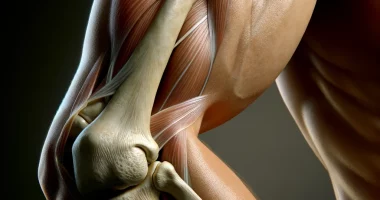Gastrointestinal stromal tumors (GIST)
Definition
Gastrointestinal stromal tumors are a group of rare malignant neoplasms of the gastrointestinal tract of mesenchymal origin. Clinical manifestations depend on the localization of neoplasia. There may be a feeling of rapid satiety, pain, abdominal bloating, bleeding, and phenomena of intestinal obstruction. At later stages, weight loss, fever, anemia, anemia, hyperthermia, and dysfunction of organs affected by distant metastases are detected. Diagnosis is based on complaints, objective examination, CT, ultrasound, endoscopic examination, and biopsy results. Treatment – surgery, chemotherapy.
General information
Gastrointestinal stromal tumors (GISTs) are a group of neoplasms of non-epithelial origin located in the submucosal layer of the hollow organs of the gastrointestinal tract. In 60-70% of cases, they affect the stomach; in 20-30% – the small intestine; in 5% – the rectum; in less than 5% – the esophagus. Occasional cases are found in the omentum, mesentery, and retroperitoneum, although the development mechanism of such neoplasia outside the hollow organs is not yet understood. Gastrointestinal stromal tumors account for less than 1% of all GI cancer lesions. They usually develop after 40 years of age, with peak incidence at 55-60.
At the time of detection, some neoplasms of this group may look benign, but experts always consider such tumors as potentially malignant. Often, there is an aggressive course; at the time of diagnosis, 15-50% of patients have metastatic lesions of the liver or peritoneum. Less often, gastrointestinal stromal tumors metastasize to bone, pleura, and lungs. The main cause of development is considered to be hereditary predisposition. Some researchers point to a link between the type of mutation and the level of location of the neoplasia. Treatment is provided by specialists in oncology, gastroenterology, and abdominal surgery.
Classification of gastrointestinal stromal tumors
After immunohistochemical techniques and electron microscopy were introduced into clinical practice, it was established that cells of gastrointestinal stromal tumors originate from interstitial Cajal cells. These cells represent a link between intramural nodes of the peripheral nervous system and smooth muscle cells of the hollow organs of the GI tract. One of the main functions of such cells is to coordinate the peristalsis of the esophageal, gastric, and intestinal walls.
Macroscopically, gastrointestinal stromal tumors are friable soft nodules of pinkish, gray, or light brown color. The diameter of the nodules may vary from 1 to 35 cm. In the growth process, such neoplasms may merge to form conglomerates or cystic structures. In the center of large neoplasms, areas of necrosis are usually found, and cystic cavities with hemorrhages can be seen in the tissue of neoplasms.
Microscopic examination of a sample of gastrointestinal stromal tumors reveals spindle-shaped and epithelioid cells spaced apart or grouped in clusters separated by thin layers of connective tissue. Cell polymorphism is noted. Rope-shaped cells form bundles and whorls. Epithelioid cells have more distinct borders; the shape of such cells is round or polygonal. The cytoplasm of spindle-shaped and epithelioid cells is light-colored, and cell nuclei are rounded or oval.
Taking into account the peculiarities of the histological structure, the following types of gastrointestinal stromal tumors are distinguished:
- Spindle-cellular. They account for about 70% of the total number of stromal neoplasms. Spindle-shaped cells with rounded or elongated monomorphic nuclei predominate.
- Epithelioid. Occur in 20% of cases of stromal neoplasia. Polygonal or rounded cells with oval or rounded light-colored nuclei predominate.
- Ileoform. They account for 10% of all gastrointestinal stromal tumors. There is marked cellular polymorphism.
Symptoms of gastrointestinal stromal tumors
There are no pathognomonic symptoms, and the clinical picture is determined by the location of the neoplasm. Swallowing difficulties, premature satiety, bloating, or abdominal pain may occur. In 20% of patients, gastrointestinal stromal tumor is asymptomatic in the initial stages. Due to the nonspecificity and vagueness of manifestations, patients consult a doctor on average 4-6 months after the first signs of the disease. Often, such neoplasia becomes an incidental finding during CT, esophagogastroduodenoscopy, and other studies. Sometimes, gastrointestinal stromal tumors are found during surgical intervention for another disease.
With the progression of cancer, more than half of patients have gastrointestinal bleeding accompanied by melena or bloody vomiting. Many patients develop posthemorrhagic anemia. The high probability of bleeding in GIST is explained by frequent ulceration of the neoplasm. In 10-30% of patients with gastrointestinal stromal tumors, there are signs of intestinal obstruction. At late stages, weight loss, loss of appetite, weakness, and abdominal enlargement due to ascites and/or growing neoplasms are detected. Palpation of the abdomen reveals a tumor-like mass. Metastasis to the liver may result in enlargement of the organ and jaundice of varying degrees of severity.
Diagnosis of gastrointestinal stromal tumors
Diagnosis is based on clinical symptoms, external examination, and objective studies. Patients are prescribed abdominal radiography, ultrasound, and contrast CT of the abdominal cavity. With low-lying tumors, patients are referred to MRI. If the stomach is affected, a gastroscopy is performed; if the large intestine is affected – a colonoscopy is performed. If metastasis of gastrointestinal stromal tumor is suspected, chest X-ray, chest CT, spine X-ray, skeletal bone scintigraphy, and other studies are performed.
If possible, PET-CT is used to accurately determine the extent of gastrointestinal stromal tumors and detect small metastases not detected by other techniques. The final diagnosis is established based on histologic and immunochemical examination of the tissue sample taken during endoscopic examination. Differential diagnosis is performed with other GI neoplasms.
Treatment of gastrointestinal stromal tumors
The main method of treating GIST is surgical intervention. The extent of surgery is determined depending on the localization and prevalence of neoplasia. The standard is radical resection of pathologic foci along with 1-2 cm of surrounding healthy tissue. The removed gastrointestinal stromal tumor is sent for urgent microscopic examination. If malignant cells are detected along the incision line, excision of the affected area is performed.
Because lymphogenic metastasis is rare, lymphadenectomy is not performed (except for gastrointestinal stromal tumors of the rectum, which metastasize to lymph nodes in 25-30% of cases). In case of single metastases in the liver, radiofrequency thermoablation or surgical removal of the secondary tumor is performed. In inoperable neoplasms, preoperative chemotherapy is prescribed, and then reexamination is performed. If there are signs of resectability, the tumor is excised; in other cases, treatment with chemopreventive agents is continued.
The prognosis depends on the location, extent, and size of the gastrointestinal stromal tumor. The average five-year survival rate is 48%. Up to 5 years from the moment of radical surgical intervention, 50% of patients manage to survive, with tumors with a diameter of more than 10 cm. This indicator decreases to 20%. There is a high probability of recurrence; within 2 years after radical resection, recurrences are detected in 80% of patients. The average life expectancy in inoperable gastrointestinal stromal tumors, according to different data, ranges from 10 to 21 months.
All these treatment options are available in more than 810 hospitals worldwide (https://doctor.global/results/diseases/gastrointestinal-stromal-tumor-gist). For example, Small bowel resection can be done in these countries at following approximate prices:
Turkey$7.0 K – in 22 clinics
China$18.4 K – in 6 clinics
Germany$20.1 K in 37 clinics
Israel$23.5 K in 11 clinics.

